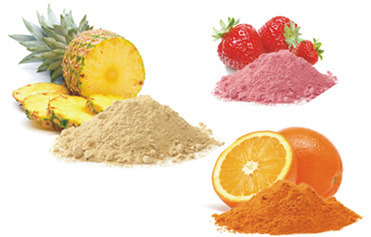Project Report For Spray Dried Food F&V Powders, Fat Powders
Introduction
Project report for Spray Dried Food F&V Powders, Fat Powders is as follows.
India is the world’s second-largest producer of veggies. As a large portion of India’s produce is exported, processing of fruits and vegetables becomes crucial. The oldest method of preserving food for a longer time is drying it. Among the many technologies that are currently known, spray drying is one that is particularly beneficial and significant due to its range of uses.

Product & Application of Spray Dried Fruit And Vegetable Powders
There used to be a significant loss in post-harvest food preservation. Food and vegetables are pulped and then dried using a spray dryer to create powder. In addition to preserving the fruit or vegetable’s nutritional content, spray drying aids in preserving its natural flavour and taste. Fat powders are tiny, emulsified fat particles that enhance the sensory qualities of the product they are added to, such as creaminess and mouthfeel. With the aid of spray drying equipment and technology, fat powders with varying fat bases and fat contents of up to 80% are possible.
Get Completely Custom Bankable Project Report
Row Material of Spray Dried Food & Fat Powder
Orange, lime, apple, banana, pineapple, tomato, cheese, tamarind, and other vegetables and fruits are required as raw materials. Packing materials of food grade are required to pack dried powders, and cardboard boxes are required to pack them in bunches.
Manufacturing Processing
The steps in the manufacturing process are as follows: (a) Pretreating fruits for 3 minutes in hot water at 60 °C and blanching.
(b) Gathering and filtering fruit pulp
(c) Use of a water-soluble drying aid.
(d) Controlled juice flow into the atomizer.
(e) Spray dryer inlet and outlet air temperature control.
(f) Powder collection from the cyclone and bottom outlet.
Market potential of Spray Dried Food & Fat Powder
The size of the world market for spray drying equipment was estimated at USD 4.63 billion in 2018 and is anticipated to grow at a CAGR of 6.8% between 2019 and 2025.
Expenses

Product Cost Breakup

Reveneue Vs Expenses

Market Trend

Growing consumer preference for functional and Ready-To-Eat (RTE) food products, as well as food processing companies’ focus on introducing products with extended shelf life, are expected to drive market growth from 2019 to 2025. Rising product usage in the pharmaceutical and nutraceutical industries for the production of antibiotics, penicillin, enzymes, and whey proteins will also drive the market during the forecast period.
In comparison to other industrial drying processes, spray drying is the most common and simple drying process used for drying any liquid or semi-solid feed. It’s also the most practical way to make heat-sensitive products like milk powder, egg powder, and coffee powder. It aids in the production of fine and granular dried powder particles that can be used as flavouring agents in food and juices, as well as fillings in bakery products. Spray dryers are thus widely used in the food processing, dairy, pharmaceutical, nutraceuticals, and chemical industries. This is encouraging manufacturers to design and develop application-specific equipment that supports various types of feedstock, such as a solution, paste, gel, slurry, suspension, and melt. All of these factors bode well for market growth. However, high installation and maintenance costs, as well as a shortage of skilled engineers, may limit market growth to some extent.
